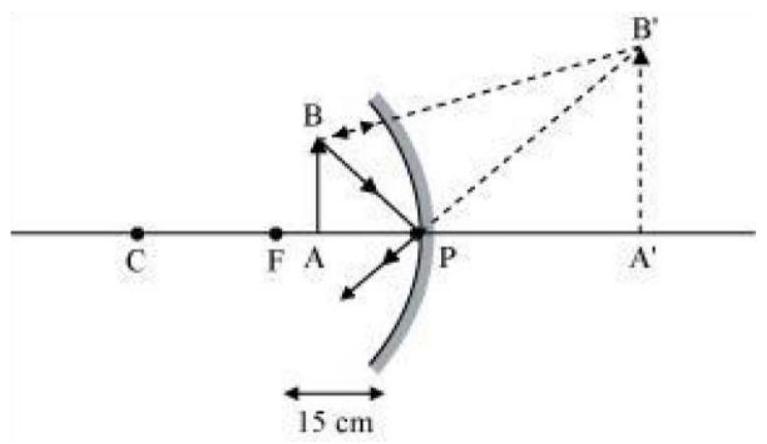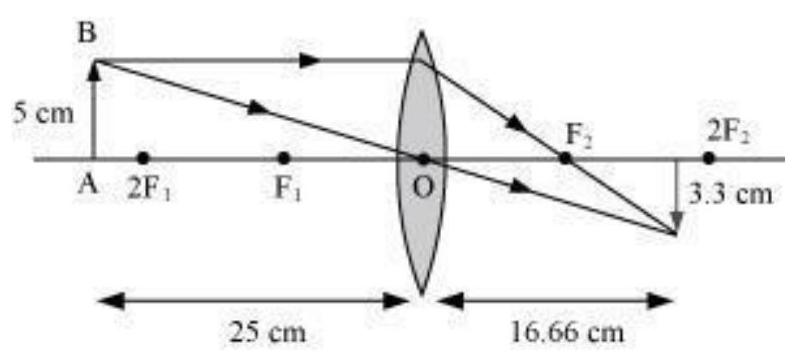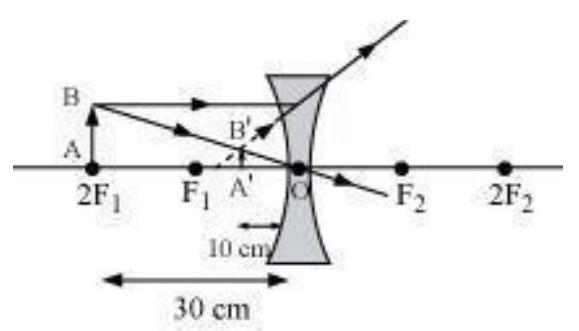Chapter 09 Light – Reflection and Refraction Exercise
EXERCISES
1. Which one of the following materials cannot be used to make a lens?
(a) Water
(b) Glass
(c) Plastic
(d) Clay
Show Answer
Answer
(d) A lens allows light to pass through it. Since clay does not show such property, it cannot be used to make a lens.
2. The image formed by a concave mirror is observed to be virtual, erect and larger than the object. Where should be the position of the object?
(a) Between the principal focus and the centre of curvature
(b) At the centre of curvature
(c) Beyond the centre of curvature
(d) Between the pole of the mirror and its principal focus.
Show Answer
Answer
(d) Between the pole of the mirror and its principal focus
3. Where should an object be placed in front of a convex lens to get a real image of the size of the object?
(a) At the principal focus of the lens
(b) At twice the focal length
(c) At infinity
(d) Between the optical centre of the lens and its principal focus.
Show Answer
Answer
(b) When an object is placed at the centre of curvature in front of a convex lens, its image is formed at the centre of curvature on the other side of the lens. The image formed is real, inverted, and of the same size as the object.
4. A spherical mirror and a thin spherical lens have each a focal length of $-15 cm$. The mirror and the lens are likely to be
(a) both concave.
(b) both convex.
(c) the mirror is concave and the lens is convex.
(d) the mirror is convex, but the lens is concave.
Show Answer
Answer
(a) By convention, the focal length of a concave mirror and a concave lens are taken as negative. Hence, both the spherical mirror and the thin spherical lens are concave in nature.
5. No matter how far you stand from a mirror, your image appears erect. The mirror is likely to be
(a) only plane.
(b) only concave.
(c) only convex.
(d) either plane or convex.
Show Answer
Answer
(d) A convex mirror always gives a virtual and erect image of smaller size of the object placed in front of it. Similarly, a plane mirror will always give a virtual and erect image of same size as that of the object placed in front of it. Therefore, the given mirror could be either plane or convex.
6. Which of the following lenses would you prefer to use while reading small letters found in a dictionary?
(a) A convex lens of focal length $50 cm$.
(b) A concave lens of focal length $50 cm$.
(c) A convex lens of focal length $5 cm$.
(d) A concave lens of focal length $5 cm$.
Show Answer
Answer
(c) A convex lens gives a magnified image of an object when it is placed between the radius of curvature and focal length. Also, magnification is more for convex lenses having shorter focal length. Therefore, for reading small letters, a convex lens of focal length $5 cm$ should be used.
7. We wish to obtain an erect image of an object, using a concave mirror of focal length $15 cm$. What should be the range of distance of the object from the mirror? What is the nature of the image? Is the image larger or smaller than the object? Draw a ray diagram to show the image formation in this case.
Show Answer
Answer
Range of object distance $=0 cm$ to $15 cm$
A concave mirror gives an erect image when an object is placed between its pole $(P)$ and the principal focus (F).
Hence, to obtain an erect image of an object from a concave mirror of focal length $15 cm$, the object must be placed anywhere between the pole and the focus. The image formed will be virtual, erect, and magnified in nature, as shown in the given figure.

8. Name the type of mirror used in the following situations.
(a) Headlights of a car.
(b) Side/rear-view mirror of a vehicle.
(c) Solar furnace.Support your answer with reason.
Show Answer
Answer
(a) Concave (b) Convex (c) Concave
Explanation:
(a) Concave mirror is used in the headlights of a car. This is because concave mirrors can produce powerful parallel beam of light when the light source is placed at their principal focus.
(b) Convex mirror is used in side/rear view mirror of a vehicle. Convex mirrors give a virtual, erect, and diminished image of the objects placed in front of it. Because of this, they have a wide field of view. It enables the driver to see most of the traffic behind him/her.
(c) Concave mirrors are convergent mirrors. That is why they are used to construct solar furnaces. Concave mirrors converge the light incident on them at a single point known as principal focus. Hence, they can be used to produce a large amount of heat at that point.
9. One-half of a convex lens is covered with a black paper. Will this lens produce a complete image of the object? Verify your answer experimentally. Explain your observations.
Show Answer
Answer
The convex lens will form complete image of an object, even if its one half is covered with black paper. It can be understood by the following two cases.
10. An object $5 cm$ in length is held $25 cm$ away from a converging lens of focal length $10 cm$. Draw the ray diagram and find the position, size and the nature of the image formed.
Show Answer
Answer
Object distance, $u=-25 cm$
Object height, ho $=5 cm$
Focal length, $f=+10 cm$
According to the lens formula,
$\dfrac{1}{v}-\dfrac{1}{u}=\dfrac{1}{f}$
$\dfrac{1}{v}=\dfrac{1}{f}+\dfrac{1}{u}=\dfrac{1}{10}-\dfrac{1}{25}=\dfrac{15}{250}$
$v=\dfrac{250}{15}=16.66 cm$
The positive value of $v$ shows that the image is formed at the other side of the lens.
Magnification, $m=-\dfrac{\text{ Image distance }}{\text{ Object distance }}=-\dfrac{v}{u}=\dfrac{-16.66}{25}=-0.66$
The negative sign shows that the image is real and formed behind the lens.
Magnification, $m=\dfrac{\text{ Image height }}{\text{ Object height }}=\dfrac{H_1}{H_0}=\dfrac{H_1}{5}$
$H_1=m \times H_0=-0.66 \times 5=-3.3 cm$
The negative value of image height indicates that the image formed is inverted.
The position, size, and nature of image are shown in the following ray diagram.

11. A concave lens of focal length $15 cm$ forms an image $10 cm$ from the lens. How far is the object placed from the lens? Draw the ray diagram.
Show Answer
Answer
Focal length of concave lens (OF1), $f=-15 cm$
Image distance, $v=-10 cm$
According to the lens formula,
$ \begin{aligned} & \dfrac{1}{v}-\dfrac{1}{u}=\dfrac{1}{f} \\ & \dfrac{1}{u}=\dfrac{1}{v}-\dfrac{1}{f}=\dfrac{-1}{10}-\dfrac{1}{(-15)}=\dfrac{-1}{10}+\dfrac{1}{15}=\dfrac{-5}{150} \\ & u=-30 cm \end{aligned} $
The negative value of $u$ indicates that the object is placed $30 cm$ in front of the lens. This is shown in the following ray diagram.

12. An object is placed at a distance of $10 cm$ from a convex mirror of focal length $15 cm$. Find the position and nature of the image.
Show Answer
Answer
Focal length of convex mirror, $f=+15 cm$
Object distance, $u=-10 cm$
According to the mirror formula,
$\dfrac{1}{v}+\dfrac{1}{u}=\dfrac{1}{f}$
$\dfrac{1}{v}=\dfrac{1}{f}-\dfrac{1}{u}=\dfrac{1}{15}+\dfrac{1}{10}=\dfrac{25}{150}$
$v=6 cm$
The positive value of $v$ indicates that the image is formed behind the mirror.
Magnification, $m=-\dfrac{\text{ Image distance }}{\text{ Object distance }}=-\dfrac{v}{u}=\dfrac{-6}{-10}=+0.6$
The positive value of magnification indicates that the image formed is virtual and erect.
13. The magnification produced by a plane mirror is +1 . What does this mean?
Show Answer
Answer
Magnification produced by a mirror is given by the relation
Magnification, $m=\dfrac{\text{ Image height }(H_1)}{\text{ Object height }(H_0)}$
The magnification produced by a plane mirror is +1 . It shows that the image formed by the plane mirror is of the same size as that of the object. The positive sign shows that the image formed is virtual and erect.
14. An object $5.0 cm$ in length is placed at a distance of $20 cm$ in front of a convex mirror of radius of curvature $30 cm$. Find the position of the image, its nature and size.
Show Answer
Answer
Object distance, $u=-20 cm$
Object height, $h=5 cm$
Radius of curvature, $R=30 cm$
Radius of curvature $=2 \times$ Focal length
$R=2 f$
$f=15 cm$
According to the mirror formula,
$\dfrac{1}{v}+\dfrac{1}{u}=\dfrac{1}{f}$
$\dfrac{1}{v}=\dfrac{1}{f}-\dfrac{1}{u}=\dfrac{1}{15}+\dfrac{1}{20}=\dfrac{4+3}{60}=\dfrac{7}{60}$
$v=8.57 cm$
The positive value of $v$ indicates that the image is formed behind the mirror.
Magnification, $m=-\dfrac{\text{ Image distance }}{\text{ Object distance }}=\dfrac{-8.57}{-20}=0.428$
The positive value of magnification indicates that the image formed is virtual.
Magnification, $m=\dfrac{\text{ Height of the image }}{\text{ Height of the object }}=\dfrac{h^{\prime}}{h}$
$h^{\prime}=m \times h=0.428 \times 5=2.14 cm$
The positive value of image height indicates that the image formed is erect.
Therefore, the image formed is virtual, erect, and smaller in size.
15. An object of size $7.0 cm$ is placed at $27 cm$ in front of a concave mirror of focal length $18 cm$. At what distance from the mirror should a screen be placed, so that a sharp focussed image can be obtained? Find the size and the nature of the image.
Show Answer
Answer
Object distance, $u=-27 cm$
Object height, $h=7 cm$
Focal length, $f=-18 cm$
According to the mirror formula,
$\dfrac{1}{u}+\dfrac{1}{v}=\dfrac{1}{f}$ $\dfrac{1}{v}=\dfrac{1}{f}-\dfrac{1}{u}=\dfrac{-1}{18}+\dfrac{1}{27}=\dfrac{-1}{54}$
$v=-54 cm$
The screen should be placed at a distance of $54 cm$ in front of the given mirror.
Magnification, $m=-\dfrac{\text{ Image distance }}{\text{ Object distance }}=\dfrac{-54}{27}=-2$
The negative value of magnification indicates that the image formed is real.
Magnification, $m=\dfrac{\text{ Height of the image }}{\text{ Height of the object }}=\dfrac{h^{\prime}}{h}$
$h^{\prime}=7 \times(-2)=-14 cm$
The negative value of image height indicates that the image formed is inverted.
16. Find the focal length of a lens of power $-2.0 D$. What type of lens is this?
Show Answer
Answer
A concave lens has a negative focal length. Hence, it is a concave lens.
17. A doctor has prescribed a corrective lens of power $+1.5 D$. Find the focal length of the lens. Is the prescribed lens diverging or converging?
Show Answer
Answer
A convex lens has a positive focal length. Hence, it is a convex lens or a converging lens.










